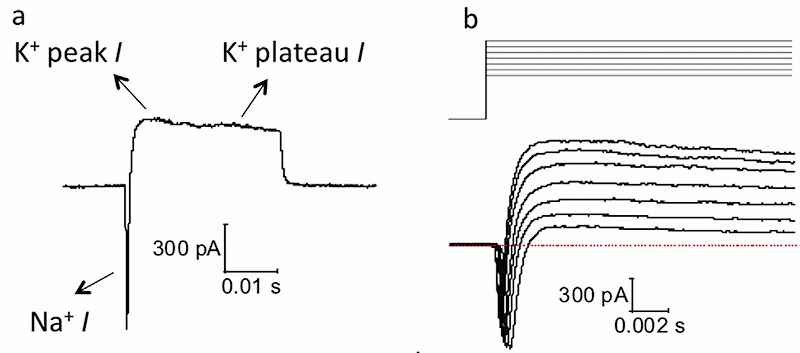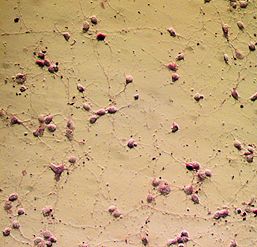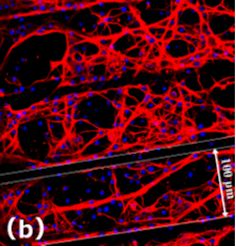 Neurons on diamond
Neurons on diamond
Diamond is bioinert, which means that living cells in contact with it do not evoke an immune response. Thus, diamond sensors or devices can be implanted into living animals, including humans, with no risk of inflammation or rejection, allowing the implant to remain in place for years, decades, or even the lifetime of the patient. Boron-doped diamond is electrically conducting, so it should be possible to pass electrical signals to and from neurons that are in contact with the diamond. This would form the basis of diamond electrodes used to simulate nerve cells in the brain or central nervous system, and possibly help to alleviate symptoms of Parkinsons', Motor Neurone Disease, epilepsy and other neurological disorders.
Another possibility is for signals to be received from the neurons into the diamond, which then pass these into an external computer which then acts on them accordingly. So, for example, an diamond electrode placed into the spinal cord of a paralysed patient might intercept the signals from the brain which normally would have gone to the legs, and then relay these to a computer which then operates a pair of robotic legs, allowing the patient to walk again. Similar diamond electrodes implanted into the brain may allow thought-controlled computers, machinery, aircraft, etc.
|
|
At Bristol we worked on this for several years in collaboration with the Neuroscience Dept (Maeve Caldwell, Paul Nistor) here at the University of Bristol. The aim was to understand how cells (neurons and stem cells) behave when placed onto diamond surfaces. We developed a protocol to culture human plurpotent stem cells on diamond which allowed them to survive for months - far longer than they would have on glass or plastic plates. Wit suitable chemical treatment, these stem cells were then converted into living human neuros, which then grew to form a 2D network. We showed that if the diamond is patterned into pathways, the neurons follow the diamond 'roads' and form a 2D living neural net. We also used electrically conducting doped diamond to study the fundamentals of how signals can be passed to and from neurons/diamond.

Electrophysiological characterization of neural differentiation on a diamond substrate. The cells were differentiated for more than 150 days before performing whole-cell patch-clamp recordings. (a) and (b) The application of successive voltage steps in VC, starting from a Vm = -82 mV, resulted in the generation of a negative inward (Na+) and positive (K+) outward current (I); the latter one included an initial peak and a subsequent steady-state plateau.
Related Papers
- P.A. Nistor, P.W. May, "Diamond thin films: giving biomedical applications a new shine", J. Roy. Soc. Interface 14 (2017) 20170382. [doi: 10.1098/rsif.2017.0382].
- E.M. Regan, A., J.B. Uney, A.D. Dick, P.W. May, J. McGeehan, "Spatially Controlling Neuronal Adhesion and Inflammatory Reactions on Implantable Diamond", IEEE J. Emerging and Selected. Topics in Circuits and Systems 1 (2011) 557-565.
- P.W. May, E.M. Regan, A. Taylor, J. Uney, A.D. Dick and J. McGeehan, "Spatially controlling neuronal adhesion on CVD diamond", Diamond Relat. Mater. 23 (2012) 100-104.
- A. Hopper, J. Dugan, A. Gill, O.J. Fox, P.W. May, F. Claeyssens, "Amine functionalized nanodiamond promotes cellular adhesion, proliferation and neurite outgrowth", Biomed. Mater. 9 (2014) 045009
- P.A. Nistor, P.W. May, F. Tamagnini, A.D. Randall, and M.A. Caldwell, "Long-term Culture of Pluripotent Stem Cell Derived Human Neurons on Diamond – a Substrate for Neurodegeneration Research and Therapy", Biomater. 61 (2015) 139-149.


